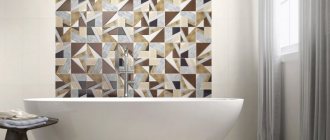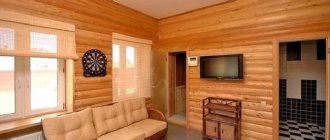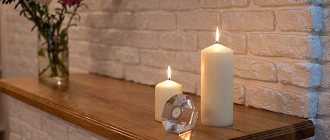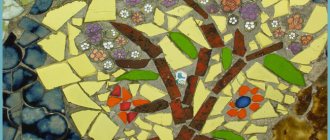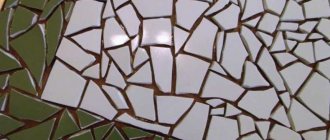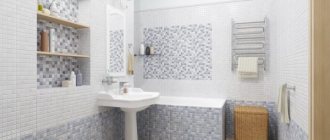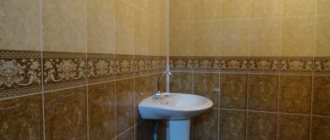New products for finishing work appear on the construction market every now and then - materials with which you can add individuality to a residential or office interior. Recently, ecological finishing has been in trend, a prominent example of which is wooden mosaic for walls.
Today’s material is about its varieties and methods of application.
Features of mosaic finishing
Wooden mosaics are small pieces of natural wood, veneer or composite materials with a wood texture ranging in size from 1 to 8 cm. They can have different shapes - square, rectangle, polygon, rhombus, etc.
Wooden mosaic for walls
Important! The texture and shade of the mosaic elements are also different, so it is possible to choose a finish for any interior.
The material is excellent for decorating walls, floors, and ceilings in apartments, houses, offices and public spaces. It is ideal for introducing the most daring design ideas.
Natural wood is a porous raw material that strongly absorbs moisture and can deteriorate from constant contact with water. Therefore, high-quality mosaic is necessarily coated with special oil-wax compounds that protect it from destruction by environmental factors. If there is such a coating, the mosaic is perfect even for wet rooms - bathrooms, baths, saunas.
Original sauna design
Most often, wooden mosaic has a base on which individual elements are fixed. Such coatings are easy to use and can be used even by beginners.
The bases are of the following types:
- Paper. The mosaic is attached to the wall using reliable glue, and the paper remains on the front side. After the adhesive composition has completely dried, the paper layer is moistened with water and removed.
- Mesh. The mesh base is the most commonly used. Pieces of wood are glued on top in the form of panels of uniform shade or with a specific pattern or ornament.
- Plywood. In this case, thin wooden blanks are fixed on sheets of plywood and form a finished drawing or picture. This material, unlike the previous one, is only suitable for flat surfaces.
Mosaic for walls Wood Mosaic Oak on a grid
Also, a wooden mosaic may not have a base at all. It is only suitable for professional styling, but it makes it possible to combine a variety of shades and textures.
What are the features of this material?
Wood itself is very attractive, because it has its own patterns and contours. Wood fibers are always unique, which makes each mosaic element original.
Despite the fact that wood is afraid of moisture and does not tolerate temperature changes, many manufacturers of wooden mosaic claim that its characteristics contribute to durability, while maintaining the original appearance.
Not all types of mosaics are durable, for the sole reason that different types of wood are used for their production. For example, pine is a durable material in itself, but it is completely unsuitable for mosaics.
Material advantages
Wood mosaic has a number of advantages that set it apart from its analogues. Among them:
- environmental friendliness, lack of toxins in the composition - there is no risk of releasing harmful fumes when heated or increased humidity in the room;
- durability, especially with strict adherence to installation technology and the presence of a protective coating;
- low thermal conductivity, heat retention in the room;
- high vapor permeability, improved microclimate in the house, absence of fungus and mold;
- excellent compatibility with other types of finishing - tiles, brick, stone, wallpaper, plaster;
- ease of dismantling, the ability to perform local repairs to the coating if individual elements are damaged;
- flexibility and adjustment to any surface contours, hiding minor defects in the base;
- improving the sound insulation of a room due to partial absorption of sound waves.
Advantages and disadvantages
The main advantage of wooden mosaic is its unique pattern, which is created by nature itself and the filigree work of human hands. The area in the room, decorated with wood material, becomes the highlight of the interior and attracts the most attention. Among other things, natural wood does not harm human health; the material is safe, in particular for allergy sufferers. Other advantages include:
• maintainability (damaged mosaic fragments can be easily replaced with new ones or, in case of minor flaws, they can be masked with wood putty);
• good wear resistance (resistance to mechanical stress, temperature changes, etc.);
• creates additional sound and heat insulation in the room;
• hides small irregularities in walls;
• good compatibility with other finishing materials (glass, ceramics, metal).
When using wood mosaics, you should take into account the disadvantages of the material. There are no significant drawbacks, however, the poor resistance of some types of wood to moisture precludes the finishing of walls in rooms with high levels of humidity. The same cannot be said about cedar, coconut, teak and other moisture-resistant species. You also need to take into account that wood periodically needs maintenance. The surface is cleaned and coated with a layer of varnish to increase its protective properties.
What types of wood are used for mosaics?
Different types of lumber are used to produce the material. The most popular types of wood:
- pine is an inexpensive material of fairly good quality, has a specific spiral pattern of structure;
- aspen is a practical raw material with a slight yellowish tint, easy to process, but quite soft;
- walnut – is in the middle price category, has a wide range of colors;
- bamboo - fits perfectly into modern style trends;
- oak - considered the most suitable option for creating mosaics, it looks noble, but costs more;
- linden - only young trees are used for finishing, since old ones quickly collapse.
Birch, ash, teak, wenge, olive, acacia, and zebrawood are suitable for the production of materials. Expensive brands of mosaics are made from rare species - amaranth, lemon, rosewood, ebony, holly.
Important! Hardwoods are most valued, although softwood cuts are also used by manufacturers.
Sometimes even barn boards are used to produce mosaics, which are pre-heat-treated and thoroughly dried. When sawing, the wood is placed at the desired angle so that the finished elements acquire an unusual texture. To create drawings, the finished mosaic is additionally fired.
Wood mosaic finishing techniques
Depending on the idea, the mosaic is laid out completely, tightly fitting the elements to each other, or a certain pattern is formed. Additionally, glass, stones, and ceramics are often used for finishing.
Inlay method
The technique involves cutting plates, elements, and parts made from expensive materials into wood (for example, ivory, glass, ceramics, metal, mother-of-pearl). All components of the mosaic should be well combined with each other in color and structure. The inserts are attached flush with the wood or pressed deep into it to form a textured surface.
There are three types of inlay techniques. The first is used for inserts of large sizes, but of a simple configuration.
The second is suitable for creating a complex ornament with an openwork image. In any case, to secure the inserts, a recess is first made into which the adhesive composition is applied, and only then the components are finally combined.
Wood inlay with metal
The third technique is an imitation of inlay. In this case, the recess in the wood is filled with a special paste that replicates the color and texture of turquoise, malachite, ivory or other materials.
Intarsia method
Mosaic consists of patterns, images, pictures made from wooden plates of different colors and types (usually no more than 4 at once). They are cut out, sanded, glued to the base, in which a recess is made in advance. Afterwards the material is polished, oiled or boiled in special paints.
Wooden panel in intarsia style
Important! This mosaic is expensive, but looks incredibly stylish and luxurious.
Block mosaic and saw cuts
The production of block mosaics is characterized by low labor costs, so its price is quite affordable, and its popularity is the highest. Take bars up to 20 cm long with a cross-section of 2x2 cm from wood of different species, glue them together in the form of a block.
Afterwards it is cut crosswise into thin plates that will have almost the same pattern. Individual mosaic elements are glued onto a base made of paper, mesh, plywood, or sold in their original form. Finished panels must be sanded and coated with varnish and wax.
Decor made of wooden blocks
Wooden mosaics can also be small wood cuts from which they make panels or decorate the entire wall with them. This type of finishing is inexpensive, fits perfectly into the interior of a wooden house, looks stylish and immediately gives the room coziness and homely warmth.
Marquetry method
The technique is simple technically, but complex artistically. Thin wooden plates (veneer) of different colors, types, and textures are glued onto a plywood base. The goal is to create original paintings, panels, and ornaments.
Important! In order for the finished product to look truly beautiful, it is important to take into account the direction of the wood grain, its exact shade and other features of the raw material.
Solid wood chest of drawers with marquetry mosaics
Where is it used?
It is used not only to decorate houses, but also cafes, restaurants and theaters, because this decoration creates a unique atmosphere in the room. It is suitable for rooms decorated in classic, modern or retro style. Suitable for country, Provence, Baroque. Looks great if the interior contains glass or metal parts. It is best to use it in large rooms. With the help of such finishing, you can highlight any part of the room, for example, a dining area, a fireplace, a relaxation area.
Mosaic production technology
Some craftsmen make mosaics even at home, however, for this purpose they will need special equipment and certain skills. Simple tiles and saw cuts can be made without much difficulty.
Approximate progress of work:
- Determine the dimensions of a wall or a separate fragment, calculate the dimensions and number of parts.
- The workpieces are cut and the edge is formed using a router.
- The parts are treated with an antiseptic to protect against mold and extend their service life.
- The mosaic is polished to give the surface perfect evenness, and varnish or wax is applied.
Color solutions
Wooden mosaic amazes with its color variety. The specific shade depends on the type of wood that was used in production.
For example, ash gives delicate, light tones of wood, oak is darker, more noble, wenge is a very dark, almost black material. A panel or wall that combines elements of different shades looks more interesting.
Advice! For small rooms, lighter finishes are usually used, and dark mosaics are used for accent decoration.
Tips and tricks
To increase the service life, the finished mosaic is coated with wax or special oils.
Mosaic does not require special care. Simply wipe it with a damp cloth and then dry it.
Mosaic can also be used to decorate a kitchen backsplash or bathroom walls, but only after treating it with varnish.
To create a more interesting coating, use three-dimensional parts or combine parts of different shapes, for example, circles and rectangles. This design is suitable for spacious rooms, as it takes up a lot of space.
Considering all the advantages of mosaic, the ease of self-installation and the way it transforms the interior, we can call it an excellent material. With it you can easily make the room unique and cozy.
Mosaic in the interior of different rooms - examples
The material is suitable for any room and fits perfectly into classic and modern styles. With its help, you can create zoning, place accents, and make unusual compositions.
Wooden mosaics are often used in bedroom interiors. Usually it is used to decorate the wall behind the head of the bed or to make a panel of elements with a relief surface.
If the material has a durable varnish coating, then it is quite suitable for arranging a kitchen apron. This apron looks especially good together with a stone countertop.
Mosaics impregnated with a fire-resistant compound can be used to decorate the fireplace area in the living room. Wooden mosaic tiles can be used in all rooms, regardless of their functional purpose. It will make the perception of the room more harmonious, and its appearance – elegant and luxurious.
Types of wood
Bedroom interior design in a modern style
The material used to create mosaics is solid wood, from the most popular to exotic species. Or raw materials in the form of waste from the wood processing industry, which, after mixing with water and cement, can be given the required shape, thickness and density.
In this case, cheap raw materials are not inferior to more expensive materials in terms of safety and external decorativeness.
Design option for a fireplace area in the living room
Mosaic made from cement-bonded materials has a grey-yellow-orange color scheme. The elements are perfectly formed into the required pattern by gluing to the base.
Original wall design for a loft interior
This mosaic has the following positive properties:
- Low cost;
- Durability;
- Moisture resistance;
- Non-flammability;
- Soundproof;
- Simple care.
Mosaic Wood Tile
Pine and linden wood is rarely used to make mosaics, as they are soft species. Therefore, preference is given to the hardest types of wood - cedar, oak, ash. Less often - alder.
Among the characteristics of wood of different species, the following can be noted:
- Pine is characterized by high cost and a pronounced radial pattern;
- Linden wood older than 10 years is fragile, so only young saw cuts are used to make mosaics;
- The soft structure of aspen makes it amenable to processing. A special feature is the presence of an original yellow tint;
- Walnut wood is varied in its shades - the palette contains a wide range of tones from dark to light. A mosaic made from such wood will adequately decorate any interior;
- Bamboo and coke shells are also used to make wall mosaics;
- Amaranth wood has a reddish-violet color and a pronounced woody texture;
- Lemon wood has an attractive golden hue;
- Anatolian walnut is characterized by a striking striped texture;
- Ebony wood has a black tint.
Decorative wall trim with saw cuts
Note! When choosing wood, they are guided not only by its natural, decorative properties and artistic expressiveness, but also by the operational properties of the material. It is worth considering that some types of wood are characterized by rapid shrinkage or slow swelling when the humidity in the room changes. These properties will affect the demands on wood processing and its service life.
The original form of mosaic elements in the design of an accent wall in the bedroom
If necessary, the natural shade of wood can be given a special shade using firing, staining, bleaching or staining. Due to this, it is possible to increase the expressiveness of the decorative panel and emphasize the storyline.
